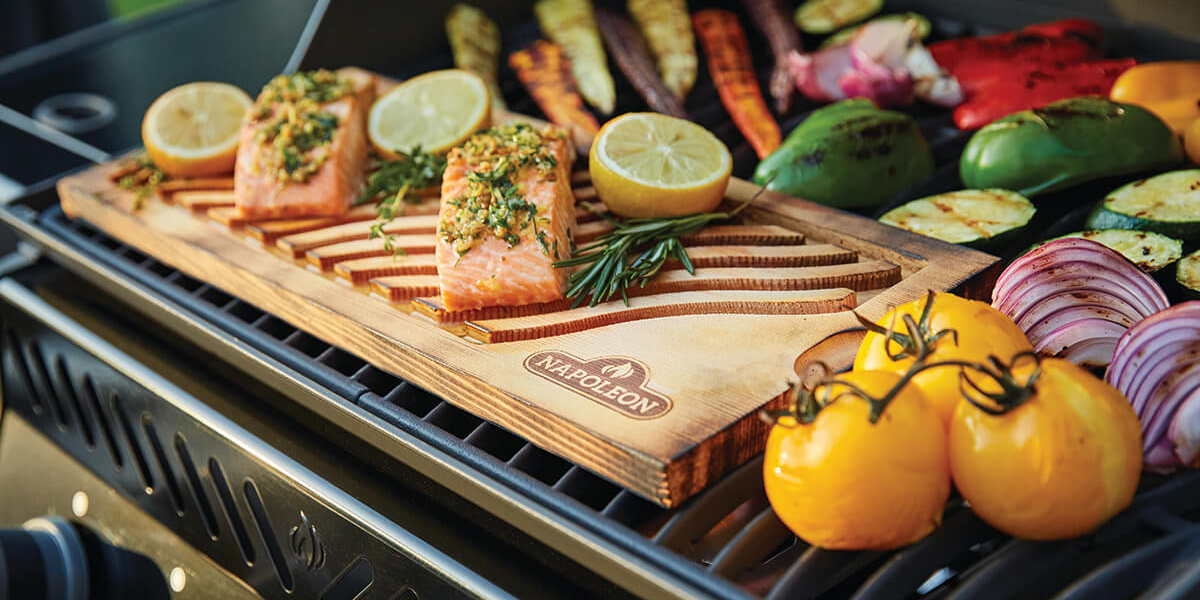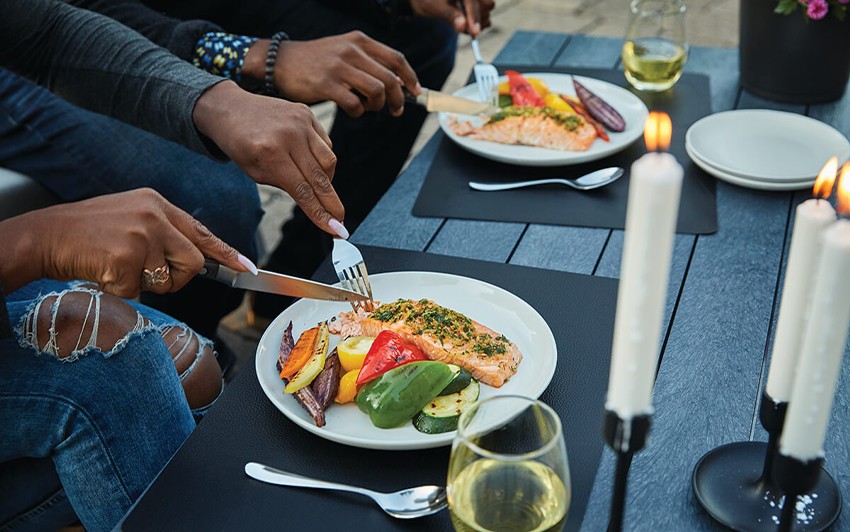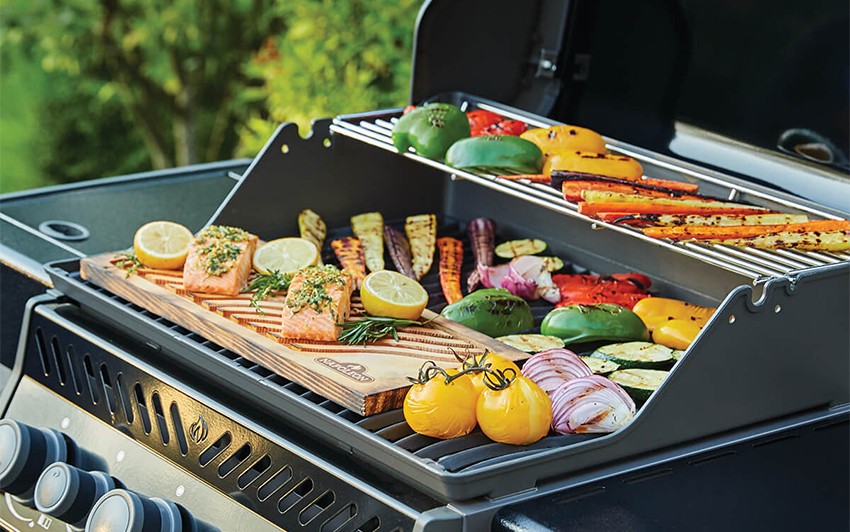
How to Perfectly Grill Salmon on the BBQ
If you love having backyard barbeques with friends and family, then a meal of grilled salmon should be on your list. It’s healthy, nutritious, versatile, and super easy to make!
In this article, we’ll cover everything you need to know about cooking salmon on your Napoleon grill. From the best salmon cuts for grilling, the most creative ways to season your fish, how to get an accurate salmon cooking temperature, to why you should leave the salmon skin on, and more!
Tips for Salmon Shopping
For delicious results, we highly recommend using steak and fillet cuts for cooking salmon on the grill. Make sure the salmon skin is still on because this effectively prevents the fish from crumbling to pieces or from sticking on the grill. It’s not impossible to grill skinless salmon but it is definitely going to take a lot of hard work to keep the fish from falling to pieces, which becomes more challenging when it’s time to flip.
Additionally, when you’re learning how to BBQ salmon, buying your fish from sustainable sources will be kinder for the environment. Ask your fishmonger for in-season and wild-caught options. There are always several varieties of salmon available either fresh or frozen at your local farmer’s market or grocery store.
Choose from the following types of salmon:
-
King Salmon (Chinook): high in fat, rich flavor, and big fish.
-
Sockeye Salmon (Red): vibrant red color, outstanding flavour, low in fat, leaner meat.
-
Chum Salmon (Dog/Keta/Silverbrite): smaller in size, lower in fat content, slightly paler flesh.
-
Steelhead Salmon: pinkish to orange flesh color, affordable option.
-
Atlantic Salmon: mild in flavor, cheap, farmed.
Contrary to popular belief, the flesh color is not a reliable indicator of your salmon’s nutritional value since this is essentially dictated by variety. A far better metric of salmon quality would be meat appearance and smell. Choose cuts of salmon that are glossy and firm to the touch. Do not accept salmon with brown spots or holes. Despite being fishy, there should also be no sour or foul odor from your meat.
How to Season Your Salmon
The great thing about BBQ salmon is that it’s going to taste amazing even with a simple seasoning of salt and pepper. But, if you want to be more creative with your flavorings, you can also try the following savory seasoning combinations that are sure to make your mouth water.
-
Lemon Salmon: lemon, kosher salt, pepper, butter.
-
Cilantro Lime Salmon: chopped cilantro, lime, kosher salt, pepper, honey, chopped cloves.
-
Spicy Sriracha-Glazed Salmon: sriracha, lemon juice, honey.
-
Soy-Glazed Salmon: soy sauce, honey, mustard, and lemon juice.
-
Salmon with Homemade Barbecue Sauce: lemon, garlic, brown sugar, soy sauce, water, and olive oil.
How to Grill Salmon Like a Pro
Now that you’ve selected the perfect cut of salmon and seasoned it, it’s time to heat up the grill! The best method to barbecue salmon can be broken down into a few simple steps:
-
Preheat your grill to medium to high temperature around 400 ℉ /205 ℃.
-
Season the salmon thoroughly and oil the cooking grids. Be sure to fully preheat the grill to prevent sticking.
-
Put the skinless side of your salmon fillet first to get beautiful grill marks. On the other hand, if you prefer crunchy and crispy salmon skin, you can do that side first. Ensure that there is an ample amount of space between each salmon piece when placing them on the grill to make sure they are cooked evenly.
-
Leave your salmon alone for 5 to 6 minutes and avoid poking, touching, or flipping them just yet. Let your Rogue® XT 625 SIB work its magic!
-
When the salmon is about 60 percent cooked, flip it to let the other side cook. Use a stainless steel wide spatula to get underneath the fish and tongs to support it while you flip. If the salmon does not release easily from the cooking grids, leave it alone for another minute or two and try again. Cooking the other side will take less time.
Salmon Cooking Temperature and Rest Time
How long does it take to cook salmon on the barbeque?
It is a general rule that it takes about 6 to 11 minutes to fully cook a piece of salmon on a properly preheated grill, like the Rogue® XT 625SIB. This is an excellent measure for a salmon that’s an inch-thick. If you have a thicker cut of salmon, fillet or steak, leave it on the grill for a couple of minutes longer. White, milky beads forming on the salmon's surface mean that it's nearly cooked through and should be watched carefully to ensure that it doesn't dry out.
There is nothing wrong with eyeballing the finished temperature of salmon - when it flakes easily, it's pretty much there - it can take time to master the technique of grilling fish. To have consistently perfect salmon, invest in a digital barbecue thermometer, like the Napoleon ACCU-PROBE Bluetooth Digital thermometer, to ensure that your salmon is cooked perfectly each time. This would make you more in control of cooking time and an expert on whether your salmon is cooked according to your desired doneness by checking the appropriate internal temperature.
-
120 degrees Fahrenheit for rare salmon.
-
125 degrees Fahrenheit for medium-rare salmon.
-
130 degrees Fahrenheit for medium salmon.
-
135 degrees Fahrenheit for medium-well salmon.
-
140 degrees Fahrenheit for well-done salmon.
A digital barbecue thermometer will ensure that you can leave the lid closed on the grill while ensuring perfectly prepared salmon. Remember to allow the fish to rest for at least five minutes before serving. It does extend your wait for dinner but assures a more succulent meal in the end.
Go crazy with your choice of sauces and sides for your grilled salmon. Rice, quinoa, and grilled vegetables are just some of the perfect pairings that make our mouths water but the choices are endless!
Do you have advice on how to BBQ salmon? We’d love to hear any tips that you might have and how your salmon recipes turned out. Let us know on our social media pages, like Facebook and Instagram!

